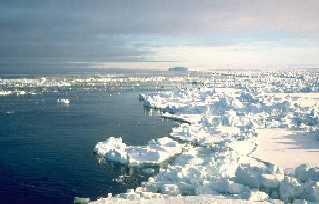|
Climate Change and Entire Landscapes on the Move
by Stephen Leahy via reed - IPS Friday, Oct 5 2007, 11:37pm
international /
environment /
other press
BROOKLIN, Canada - The hot breath of global warming has now touched some of the coldest northern regions of world, turning the frozen landscape into mush as temperatures soar 15 degrees C. above normal. Entire hillsides, sometimes more than a kilometre long, simply let go and slid like a vast green carpet into valleys and rivers on Melville Island in Canada’s northwest Arctic region of Nunavut this summer, says Scott Lamoureux of Queens University in Canada and leader of one the of International Polar Year projects.

Open water in sea ice
“The entire landscape is on the move, it was very difficult to find any slopes that were unaltered,” said Lamoureux, who led a scientific expedition to the remote and uninhabited island.
The topography and ecology of Melville Island is rapidly being rearranged by climate change.
“Every day it looked different,” he told IPS. “This is a permanent change.”
Normally Melville Island’s 42,500 sq kms are locked in sea ice all year round, as it is part of the high region that has been relatively unaffected by the dramatic declines in Arctic sea ice over the past decade. Until this year, that is. This summer, southern parts of the island were free of sea ice, Lamoureux told IPS. He has led expeditions to the island every year since 2003.
On land at Mould Bay on the island’s northwest side, his research team measured record-shattering temperatures of between 15 to 22 degrees C in July. Until then, the normal July average temperature had been between 4 and 5 degrees C.
The extraordinary heat thawed the tundra permafrost — permanently frozen ground — to depths of more than a metre, he said. At that depth, there is mostly ice and when it melts, it destabilises the thin, top layer of plants and soil that has patiently built up over thousands of years.
Enormous amounts of water and sediments are being discharged into rivers, lakes and oceans. Studies are underway to determine the impact on birds, fish, musk oxen and other creatures that live there in the summer. Given the extent of the changes, there is little doubt there will be significant ecological impacts, he said.
The record low level of sea ice in the entire Arctic Ocean will also change regional and even global weather patterns. Much more snow will fall in the Arctic due to the increased moisture from the increased amounts of open water. All that water is also dark and heat-absorbing instead of sunlight-reflecting ice, so the region gets warmer, melting more ice in what is a strong positive feedback loop.
Other parts of the Arctic region have already changed dramatically in the past 50 years.
“There are trees and lawns in Nome (Alaska) now,” said Patricia Cochran, chair of the Inuit Circumpolar Council.
“I never thought I’d see trees growing on the tundra,” Cochran said about her hometown, which lies on the Bering Sea and was once too cold for trees to grow.
“Beavers are overrunning the area now that there is food for them. They are even in Barrow, north of the Arctic Circle,” she told IPS from her office in Anchorage.
The tundra is also melting, resulting in coffins disturbingly popping out of the ground in graveyards, roads crumbling and giant sink holes opening up everywhere, including in some towns, she said.
Every summer brings plants, animals, birds and insects that no one has seen before. Dragonflies and turtles now roam the lands that had been too icy for tens of thousands of years.
“Everyone living here has seen the changes,” Cochran said.
And there are more changes to come even if politicians and corporate CEOs stop pretending to act and actually curb emissions of greenhouse gases.
“The Arctic Ocean will be ice free in the summer, it’s just a matter of how soon,” said Andrew Weaver, a climatologist at the School of Earth and Ocean Sciences in the University of Victoria, Canada.
A new study led by the U.S. National Aeronautics and Space Administration this week revealed that the Arctic’s thick, year-round sea ice cover declined 2.6 million square kilometres beyond the summer average minimum since satellites started measurements in 1979. That’s about the size of the province of Ontario.
“That decline is nothing short of stunning,” Weaver told IPS.
It’s also a permanent decline because while the ice will re-form over the six-month-long winter when there is no sunlight, it will be much thinner and likely to melt quickly next summer, he said.
Because Arctic sea ice is floating, the melting will not affect sea levels but it will “wreak absolute havoc on Arctic ecosystems”.
The rapid meltdown is pushing the upper end of the climate experts’ projections, he said, noting that new research shows that change in the Arctic could happen abruptly. In other words, the worst case scenarios and beyond may come to pass. They may even be on their way right now.
Oil and gas exploration may one day reach remote Meville Island if there’s a summer ice-free path because of the extensive natural gas and oil reserves there, said Lamoureux.
Burning such fossil fuels is the major reason why the Arctic is losing ice. Scientists and native people note that it would be more than ironic should those emissions facilitate the extraction of even more fossil fuels with which to further warm our overheating global greenhouse.
© 2007 Inter Press Service
http://www.commondreams.org/archive/2007/10/05/4348
<< back to stories
|